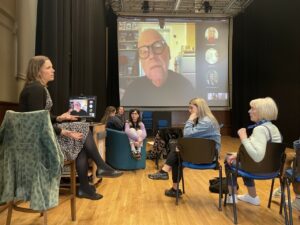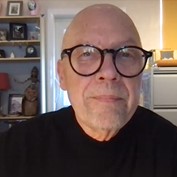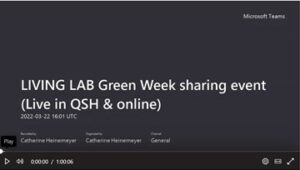‘As an artist, it is making me consider which are the best ways of engaging with the public in order to enable change. As a citizen, I can say that it is making me more aware of habits I need to keep and ones I need to pick up.’
Adina-Diana Pop, second-year Drama student, reflects on how the Living Lab has helped shape her thinking.

Sarah Williams (left) shares her work in the Estates Department.
Last week, groups from a variety of modules gathered for a Green Week sharing event to discuss their ambitions for the project and to find out how others have interpreted the brief. With staff and students from Fine Arts, Linguistics, Drama, Biosciences, Geography and more, the session sought to encourage communication across departments and to explore and recap student ideas. As well as students sharing their work so far, there were insightful and inspiring talks by David Haley, from Chrysalis Arts, and by Sarah Williams, as part of the Estates Team at York St John.

David Haley, above, sharing his love of green art.
As the event commences, David Haley introduces himself and the organisation he works for, Chrysalis Arts Development. Haley became an ‘ecological artist’ in 1992 in a time when, as he says, the effects of climate change were just coming to the forefront of public life. He describes his work as looking into a ‘nexus of climate, species, and cultural crises’, and he was initially drawn to Chrysalis Arts for its ‘greening arts practice.’ The organisation will be working with Fine Art students to explore ways art can becomes more sustainable over the next semester. In his talk, Haley asks the question ‘what is air?’ and invites everyone to think about what significance air has for us. He simply explains the Great Oxygenation Event, which occurred roughly a billion years ago, and how life began to form and initiate a ‘new wave of evolution’. Haley follows this up by asking ‘how does air connect us to others?’, to which some students were repulsed by the idea of breathing ‘recycled air’. Whilst it is a strange thought, especially regarding the spread of disease, Haley reminds everyone to think expansively about air and its value.
This is followed by a talk by Sarah Williams from the Estates Department, who ensures that ‘buildings and spaces on campus are fit for purpose’. Williams expresses concern over the air quality and explains that it brings with it many logistical challenges that the department cannot always address. She gives the example of the seating area outside of the De Grey building, which is only a few meters away from the junction. ‘Should we have seating area measures?’, she asks, should we put messaging up or change the space? Williams discusses the need for data collection on how air quality effects staff and students, as well as finding out the most popular modes of transport. Being in a high-profile location and having social influence, she explains, our university could make radical change, and perhaps challenge the local council to allow for more greenery on buildings, such as seen in Singapore.

Tipton, Ostrowska, and Pop.
The final presentation came from second-year Drama students, for the module Politically-Engaged Practice 2—in which they plan an ‘activist performance that will engage the public.’ The three students, Tipton, Ostrowska, and Pop, are in the process of making a banner which will be hung at the junction. The banner will read ‘Open Your Window, Breathe Our Air, How Will it Taste?’ This compelling slogan encourages drivers to think about their habits, and to turn off their engines when possible. The three are also collating opinions on air quality both on-campus, and at primary schools, this data will then be turned into spoken word poetry and to artistic displays.
After the event, Adina-Diana Pop shared some thoughts on the event and how the Living Lab has shaped her thinking. She writes:
“I have always tried my best to behave in a way that doesn’t cause more damage to the environment, but it was something that I was engaging in without fully realising how close to home the issues are. The Living Lab opened my eyes and made me realise that action towards improving the quality of our environment within local areas must be taken, otherwise greater issues might surface.
As an artist, it is making me consider which are the best ways of engaging with the public in order to enable change. As a citizen, I can say that it is making me more aware of habits I need to keep and ones I need to pick up.”
In case you missed it, you can watch the recording here:

Watch here.